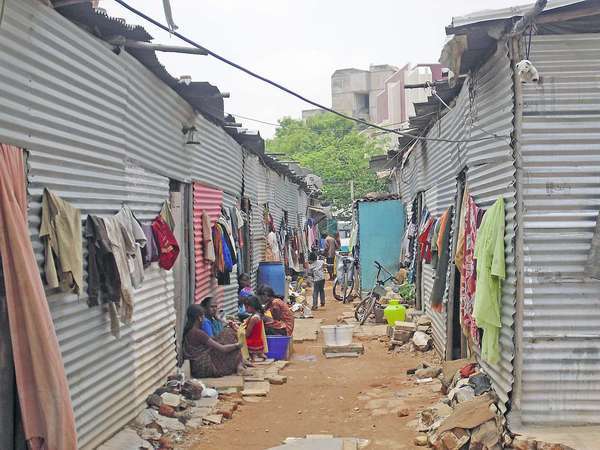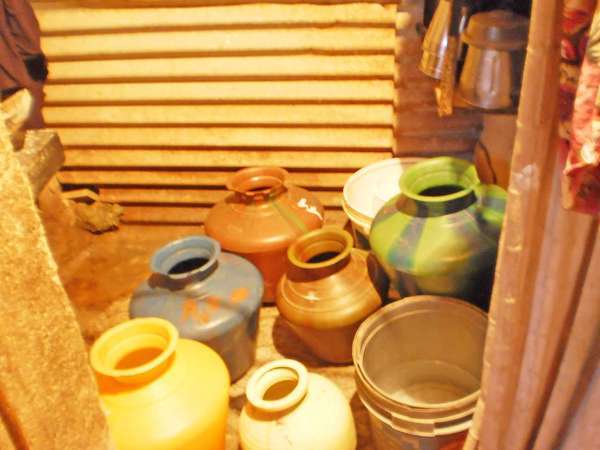The tin sheet shacks in Ejipura EWS (Economically Weaker Section) quarters are lined up so close to each other, that it is not easy to tell one house from the next. Outside the shacks, little girls and boys are seen carrying small pots of water which they have collected from somewhere.
In one of the houses stays Aisha (name changed), with her husband, four children, and parents-in-law. Like most families here, this family of eight also does not get water to their house. Aisha, 38, spends a lot of her time standing in queue in front of public taps.
Children in Ejipura slum take a break in between carrying water. Pic: Navya P K
Her son, the oldest, is 15 and studying in a madrassa. Her three daughters are aged 11, nine and seven years. All three of them study in an Urdu school in Austin Town. It is around 3 pm on a weekday, and the children are back from school.
The girls are busy doing their homework, bent down on a thin carpet on the otherwise bare floor of the living room. They are quiet, looking up quizzically and smiling sometimes, and then getting back to their books. The small living room only has a cupboard, TV, and a table upon which clothes and pretty much all belongings of the family are piled up. Aisha’s husband, also 38, is an auto driver.
Fair and sturdy, dressed in a pink salwar-kameez, Aisha is busy moving around the house, cooking and doing other chores. She catches her breath in between, talking about her problems for a couple of minutes, and then moving on to do some more work. Her sister-in-law – who stays nearby – is around, giving more details of the problems here.
Aisha had not always been a homemaker. She used to work as a domestic help, supplementing her husband’s income. But now she spends hours searching for and collecting water daily. This, in addition to taking care of the children, led her to give up her job. She only goes to work rarely, when her former employer calls her in case of an emergency.
The problem is that even the public taps in the quarters do not have water everyday. While BWSSB can boast of having put public taps in most slums, the fact is the taps are dry most of the time. In Ejipura quarters, over 1500 houses are spread across a huge area, one row after the other. But water comes only in a few public taps close to the main road. That too, once in two days, for four hours in the night. Aisha often goes with her mother-in-law or neighbour to collect this water.
Ejipura Slum. File pic
The family owns only eight plastic water pots; water can be collected in these only. There is only as much space inside the tiny bathroom in the house, to store the pots. Each pot has capacity of 15 litres. In addition to the bathroom, there is only the living room, and a kitchen with space for only one person to stand. The water for drinking and cooking is stored in a big steel vessel in the kitchen. It is too heavy to be used for collecting water, and is used for storing it only.
The eight pots of water that Aisha collects from the public tap is supposed to last for two days, but often it doesn’t. The family’s requirement is much higher. Aisha says that she adjusts somehow. Everyday, some 6-7 pots of water are for drinking and cooking alone. Aisha cooks thrice a day for the family. She uses one bucket of water to clean the house daily. The drinking glasses and plates are kept on the floor itself as there is no other furniture. “Since the area of the house is less, one bucket is enough. If it is not cleaned daily, we may fall ill,” she says.
A lot of water is spent for washing clothes too. Washing is done once a week, and 15-20 pots are needed for this. If washing a few clothes is urgent, Aisha collects some water somehow and uses it. Bathing is a luxury that happens once in 2-3 days.
She says that much of the water is needed for children. She sends half-a-litre water bottles for each of them to school. “The children have to be sent clean to school. Their uniform has to be washed regularly,” she says.
From one tap to the next, in search of water
Like most people in the quarters here, Aisha too goes around seeking water daily. She could get lucky sometimes. There is a church about ten minutes walk from the slum, where a public tap sometimes gives water. Another source is the borewell water which gets pumped into the public toilets in the slum. “We take water from the tap outside the toilets. As long as power is there, water gets pumped into this tap. But power cuts are very common here,” says Aisha.
The bathroom in Aisha’s house where the water pots are stored. Pic: Navya P K
In addition to all this, almost everyday, Aisha’s husband, an auto driver, has to go all the way to Viveknagar to fetch water from a public tap. After completing his work at night, he goes by auto with the water pots. He has had health problems for the last 12 years, and had a surgery very recently.
Aisha is not happy about him going to work or bringing water, as he is still not in good health. “But we have taken debts for the surgery, so he has to work. After going around in the auto for the whole day, he again has to go to fetch water late at night. I cannot go by myself as the area is too far,” says Aisha. She says that using the auto for fetching water is an additional expense.
Battle for water
Because of severe shortage, there is conflict within the community for water. Often, those living close to these taps get more ownership over it. Aisha says that the houses nearby have taken illegal connections from the taps to their own houses.
“They have fixed motors on public taps and collect this water in tanks. Once water comes at 7 pm, they collect it till 8.30 – 9 pm. Only then can others start collecting. These people also demand money from us often, and also ask us to pay for repairs of their motors,” explains Aisha’s sister-in-law, who stays nearby. Even then, people start standing in queue by 7 pm. By the time most people get water, it would be 10.30 – 11 pm. Water supply also stops by then. Aisha says that there have been times when she stood in queue till 11 pm, and had to come back without any water.
Ejipura Slum. File pic
“Some plead for water, others fight with those who take water from illegal connections. If only us women are going, we cannot do much. Generally it is difficult for women to go alone at night here,” says Aisha. There are a few lanes in the quarters that have public taps, but water does not come to most of these. Aisha’s lane does not have any taps at all.
For namesake, there is a tap in the bathroom of her house, but water has never come to this tap. It’s the same with most houses here.
Health problems common
Everyone uses the damaged public toilets – three each for men and women. There is a queue daily from 6 to 8 am, to use the toilet. Residents have to pay Rs 2 for every time they use it. “This itself is a cost for the family. It is embarassing for women and young girls to stand out in the queue to use the toilet,” Aisha says.
Dengue and chikungunya is frequent here, even among children. Water that is stored for long, leads to mosquito breeding which causes these diseases. The water from public taps is such that, worms start appearing if it is stored for 3-4 days, Aisha says. Sometimes the water simply is dirty. This water is used for all purposes except drinking.
Aisha is well aware that her family is more vulnerable to diseases if water is not boiled. She keeps the borewell water collected from near the public toilets, for drinking and cooking. This water is salty, but not as polluted as public tap water. But she says that she cannot afford to use the gas frequently to boil water.
“I am also worried because now only six gas cylinders can be used in a year. Ours is a large family, and we have to make the cylinder last somehow,” she says. She boils water only when any of the children are unwell. There is no money to buy a water filter.
Today is one of the days when water comes, and Aisha is finishing chores early and getting ready to stand in yet another long queue. As 2012 ends in Bengaluru and 2013 begins, Aisha and others here are not expecting any change. Conditions have been like this for long.⊕




one of a best published matter to open eye to adminstrater of corporation